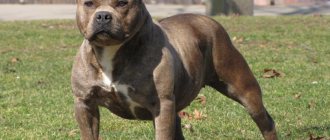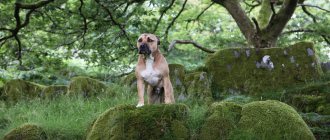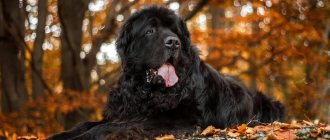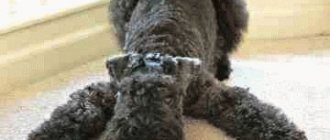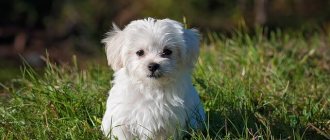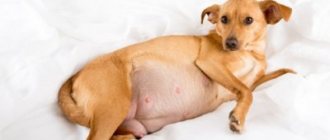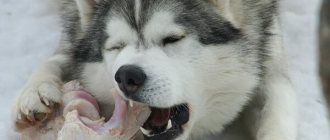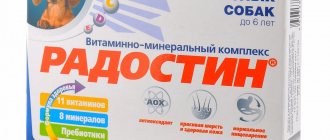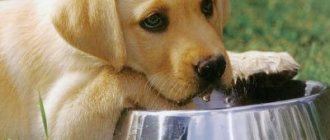- Pets
- >>
- Dog breeds
* Here is a photo of a typical representative of the Newfoundland dog breed . You can send us photos of your animals by email, and we will post them on the website. Don't forget to send your pet's name.
Other breed names:
Diver
Video
* We invite you to watch a video about the Newfoundland . In fact, in front of you is a playlist in which you can select and watch any of 20 videos about a given dog breed by simply clicking on the button in the upper right corner of the window. In addition, the material contains quite a lot of photos. By looking at them you can find out what Newfoundland looks like.
In this article:
|
Rate the material!
[Total votes: 2 Average: 5]
The Newfoundland is a giant dog that hides a good-natured and affectionate character behind its stern appearance. These dogs are happy to meet new people, love to communicate with other animals and will never offend those who are weaker than them.
History of the origin of Newfoundlands
Newfoundlands (they are also divers) do not have a clear origin story. There are three main versions according to which these dogs were bred. The first version refers to the Vikings, who bred “bear dogs”. These were large animals that accompanied their owners on military campaigns.
The second version is that divers descended from Tibetan mastiffs. There is no evidence of this, but mastiffs are the oldest breed of dog, and also one of the largest. Divers are physiologically similar to these strong dogs.
The third version is that Newfoundlands formed independently as a breed. Dogs lived near seas and lakes, so their fur evolved to have water-repellent properties. The size of the breed was achieved through crossing with other large dog breeds such as Molossians, Mastiffs and Shepherds.
Interesting fact: The dog originates from the island of Newfoundland, after which it got its name. This island was visited by both Vikings and Greenlanders, so which of them first began to develop the breed is an open question. The discoverer of the breed is considered to be John Cabot, who arrived on the island in 1497.
Over time, the open Canadian island served as the name for an unusual breed of dog. George Cartwright was the first to call waterfowl dogs Newfoundlands, paying tribute to the historical homeland of these dogs. It was from this time that dogs began to bear this name, and before that they were simply called divers.
Origin of the breed
The first written mentions of Newfoundlands date back to the 18th century, but in the canine community it is believed that their ancestors are much more ancient. Back in the 10th century, large, hardy dogs lived alongside the indigenous peoples of the island of Newfoundland, which is located off the coast of North America. They helped with fishing, carried loads, looked after children, pulled nets, and rescued drowning people. When the Vikings came to the island, the blood of the dogs was added to the blood of a large bear dog, and when the colonization of the island began in the 16th century, then the blood of other breeds was added.
Already by the 18th century, the exterior and behavioral characteristics were determined, and towards the end of the century the first breed club was formed. Since then, the dogs have always remained consistently popular.
In the USSR, by crossing them with shepherd dogs, they tried to get the “Moscow Diver” breed, which, despite all the advantages of the Newfoundland, would not have a block on aggression towards humans, but it was not possible to achieve a satisfactory result.
Newfoundland - description of the breed
Newfoundlands are huge, massive dogs. They have a robust body that is both powerful and compact. They have well-developed muscles, so their movements are well coordinated. The length of the body from the withers to the tail is strictly proportional to the height of the dog from the withers to the ground. Bitches are less massive than males. The back is straight, strong, withers and croup are clearly defined.
The Newfoundland's head is large, with a wide skull. The cranial vault is convex, which makes the dog’s profile expressive. Divers have a well-developed occipital part; the occipital protuberance is easily palpable. The muzzle is square in shape, quite deep relative to the head and slightly shortened. The fur on the face is thin and short, there are no folds. The outlines of slightly hanging lips are clearly visible, but the mouth is tightly closed. The cheeks are soft, slightly saggy.
The Newfoundland's nose is large, wide, with well-developed nostrils. The color is most often black, but brown shades are allowed. The dog has a scissor or straight bite; snacking is not allowed. The teeth grow strictly at right angles to the jaw.
The eyes of these dogs are small, deep-set and slightly slanted, which is why they look sad. Set quite wide apart. The eyelids do not droop, like in St. Bernards, and the red part of the eyes should not be visible. In terms of eye color, most often they are brown or amber, according to their color.
Newfoundland ears are small, triangular in shape and slightly rounded at the tips. They are planted on the back of the skull, symmetrically to the cheekbones. The ears, extended forward, easily reach the dog's eyes.
The divers' neck is strong, smoothly merging with the shoulders, and long enough to ensure a noble carriage of the head. Has a graceful curve. The dog's chest is rounded, the shoulders are slightly sloping, and the muscles are well developed.
Breed standard
The Newfoundland in the photo looks like a big black bear cub. It looks massive and powerful. When you get to know the dog in more detail, you can be convinced that in life he is a perfect good-natured person, reminiscent of a plush toy and has a gentle character.
The four-legged friend has a massive head, a wide skull with a developed tubercle on the back of the head. The transition from forehead to muzzle is noticeable, but not sharp. The nose is well pigmented, the nostrils are large. Depending on the color, the color of the lobe varies and can be either black or brown.
The muzzle visually resembles a square. The dog has a scissor or level bite, and looks at the world with small, deep-set and widely spaced dark brown or lighter eyes.
Newfoundland age 3 years
The neck is muscular, firmly supported by the shoulders, long enough for a noble carriage, flowing into a massive body with a deep, strong chest. The back is wide and the loin is strong and overly muscular. The paws are straight and parallel even when walking, at the ends they are gathered into a ball with strong toes.
Developed membranes are visible between the fingers, and the claws are black or horny. The tail serves as a rudder for the dog when it swims, so it is strong and wide at the base. When at rest, it is lowered and slightly bent in the last third. In a state of excitement, raised high, curved upward.
The coat of this breed has water-repellent properties. The hair is long, straight, and sometimes wavy. The undercoat is soft and dense to the touch. Color options are black, black and white or brown.
Black, even anthracite, is considered traditional, very rich. There may be white spots on the chest and fingers, as well as the tip of the tail. With a height at the withers of up to 71 cm, males weigh about 68 kg. The height at the withers of females reaches 66 cm, and the weight is 54 kg.
Disqualifying faults include bad temperament, problems with bite, smooth coat, markings of any color other than white, as well as other types of colors other than the three listed.
Popular Newfoundland colors
Newfoundland wool has special properties, largely for which the dog is called a diver. It completely repels water and has a double undercoat. With such fur, the dog is not afraid of cold water or severe frosts, but dogs do not tolerate heat well.
The top coat is very smooth, silky and thick. The hair is long, strong and thick, and does not get wet at all in the water. The fur does not have any curls or curls - it is perfectly smooth and even. Both layers of undercoat are soft and dense. The hair is greasy so that the water-repellent properties are even stronger.
The head, muzzle and ears are covered with a thin layer of fur. This allows dogs to see well underwater and also does not hinder their movement. There is no fringe on the chest that would get wet and weigh the dog down. The tail is also covered with long thick hair, but without undercoat.
Interesting fact: For a long time it was generally accepted that Newfoundlands could only be black. At the moment this is not the case: cynological associations recognize several other colors, which must comply with certain conditions.
The most common color is black. It is thick, blue-black wool. It can fade in the sun and become a little reddish or brown, but with each molt the color returns. No spots are allowed, although some organizations allow a white spot on the chest.
Landseer is a black and white color that is extremely rare. Only about twenty percent of the dog population has this unique color. These dogs are more like St. Bernards.
Chocolate or bronze shades are also common, but have only recently been recognized. Deep silver is also a rarity among representatives of this breed.
Character and habits of Newfoundlands
Despite their enormous size, Newfoundlands are very affectionate, good-natured and open dogs that are ready to love all the people around them. This character was formed due to the fact that dogs have been rescuers for a long time: they found people and pulled them out of the rubble of buildings or saved drowning people. These dogs have an innate instinct to save drowning people.
Divers are good watchmen: they understand what territory belongs to his family and are ready to protect it. Newfoundlands love to learn new things, so they are highly trainable. In addition, these dogs are playful, so they love to play with children. They will never hurt a child and will make sure that he doesn’t get into trouble, so these dogs are also good nannies.
However, children can harm these huge dogs. Newfoundland bones are not as strong as they seem at first glance, so riding a dog, including in sleds, is strictly prohibited. The skeleton of the dogs is designed for comfortable swimming, and not for carrying cargo.
Newfoundlands get along well with other animals. They do not harm small dogs and cats and treat all animals that are smaller than them with care. Some Newfoundlands are even afraid of very small hamsters and mice.
Interesting fact: Trained divers are well aware of their strength and size, so they will not carry their owner during a walk, dragging the leash. These dogs are fearless and are not afraid of loud noises or strangers.
In addition, divers are very curious dogs. Most of all, they like to watch people's actions, which makes them even better “nannies” for children. Newfoundlands arouse a lot of interest in new objects, so they are always eager to sniff and touch an unfamiliar thing.
Interesting facts about Newfoundlands
Newfoundlands have often been depicted on postage stamps, coins, postcards, advertising brochures, and in urban graffiti in Canada. These popular dogs were minted on coins in New Zealand.
Landseers are black and white Newfoundlands, sometimes classified as a separate breed. They are named after the artist Edwin Landseer, who adored these dogs. Landseers do not differ from ordinary divers in anything except their specific color.
Silver-gray Newfoundlands are recognized only by the Kennel Club of America as an independent breed, but other cynological associations classify them as ordinary divers. In the CIS countries there is a prejudiced opinion towards silver divers, which is why they are not even allowed to participate in exhibitions.
Newfoundlands are very gentle, sensitive and empathetic dogs. They know how to find people’s pain points, recognize this pain and try to help the person. For example, they may begin to lick the sore spot or try to warm it up. Some people claim that it really helps. Therefore, Newfoundlands are sometimes recommended for people who suffer from diseases of the bones and joints of the legs.
Newfoundland wool is soft and silky. It's great for knitting everything from mittens to sweaters. Things turn out to be very soft and waterproof.
Newfoundlands are like people in that they dream. They whine and scratch their paws more often than other dogs while sleeping, and sometimes even wag their tail.
Pros and cons of Newfoundlands
The advantages of Newfoundlands include the following facts:
- These are smart dogs with flexible intelligence. In an emergency situation, they are able to make decisions independently. For example, if a diver sees a drowning person, he will choose the strategy that will be most optimal for saving the drowning person;
- Newfoundlands are trainable. They are happy to learn new commands and are interested in performing tricks;
- Newfoundlands love people. They are endlessly loyal to their owners and are ready to follow them everywhere. These dogs adore children and even realize their responsibility for them. They can be safely left next to children, since the dog will never offend a child or leave him alone;
- These dogs realize that they are stronger than people, so they will never harm them. Dogs of this breed are completely good-natured and affectionate, therefore they are very courteous in dealing with both people and other animals;
- Newfoundlands are fearless. They are not afraid of trains and cars, and are not afraid of sharp sounds. This makes them good watchdogs.
The disadvantages of Newfoundlands include:
- Constant coat care. The thick, long coat of divers requires regular brushing;
- Dogs this large cannot be kept in an apartment. They will not be comfortable because they require a lot of space;
- These dogs cannot tolerate heat and can suffer heatstroke;
- They have fragile skeletons, so don't overload dogs, even if they're happy to carry your heavy items.
Raising and training a Newfoundland
One has only to look at the list of qualities to conclude that raising a representative of the breed is easy. He likes to interact with his owner, he is always happy to please and be useful, he will never snap back or try to take a leadership position.
The main thing is to avoid classic mistakes and not discourage the dog from learning.
It is forbidden:
- Use strict training techniques that dog handlers recommend when working with service dogs. Raise your voice, roughly pull the leash, press him to the floor by the withers, especially spank or hit him with full force. In order to raise a companion, this is simply not necessary - in such ways you can only break his psyche, but in no way achieve unquestioning obedience.
- Pamper a puppy, but then demand obedience from an adult animal. This is a common mistake: owners are touched by a little puppy who has wonderful paws, ears and eyes, allow him to climb onto the sofa, bite in the game and give handouts from the table, but then they wonder why an adult dog demands all the same things, and begin to be harsh retrain. But it was enough to simply not teach.
- Change the rules on the go. This is also a common case: the owner is in a good mood and allows the puppy to climb onto the sofa, lie down next to him and put his head on his knees. And then, in a bad mood, he scolds and reprimands for the same thing. This is a surefire way to confuse your pet and completely mix up the rules. He is not a telepath and is not able to understand why the same action causes diametrically opposed reactions. The same problem occurs if one of the family members forbids the puppy something, while the other allows the same thing and even encourages it.
- Study little by little and forget about education the rest of the time. This happens with children too: adults do not take into account that both the child and the dog are constantly learning, and not just during the time officially allocated for training. Therefore, you need to track all your actions, and not just those that take place on the training ground.
You need to work with the puppy constantly, from the moment he first comes into the house. It is best to do this in a playful way: while playing, learn commands, while playing, learn tricks. The only area where play is inappropriate is negative reinforcement. It is impossible to accustom a small puppy to the concept of “no” in a game.
An important part of education is socialization. From up to six months, the puppy should be regularly taken to dog parks and introduced to other representatives of the species. Otherwise, having met them as an adult, he may discover timidity or a complete lack of understanding of why he should communicate with other dogs at all.
If this particular pet is the owner’s first - or if something doesn’t work out for them and training does not produce results - it’s worth going to canine training courses, where the owner will be taught ways of communication that will be understandable to the animal. If a tendency towards aggression or excessive shyness is discovered, it is worth showing him to an animal psychologist: these are most likely mental defects or the result of serious mistakes in upbringing that need to be urgently corrected.
Breeding Newfoundlands
A Newfoundland female's first heat begins when she is six months or a year old. If mated, the dog may become pregnant, but mating at such an early age should not be done under any circumstances. The dog's body has not yet developed to bear puppies, this can greatly harm the health of the pet and future offspring. Estrus should occur regularly and evenly, and a dog can be bred when it has gone through at least three heats.
For mating, it is worth choosing the middle of sexual heat - during this period, mating, as a rule, goes most smoothly. It is worth contacting the owners of the Newfoundland male in advance to clarify whether the dog has received all the vaccinations and whether his pedigree in the passport is accurate. When breeding, it is better to take with you a specialist who understands this breed.
Newfoundlands tolerate pregnancy favorably, although it is always stressful and strains the body. In total, the pregnancy period lasts 63 days, but it may drag on for an extra week - this is not critical. The dog should be isolated from unnecessary stress, especially in the last months of pregnancy. Your Newfoundland should always have access to plenty of food and clean water.
Particular attention should be paid to temperature conditions. The room in which the dog will give birth should not be too warm. It is better to keep windows or ventilation open, but a pregnant dog should not be left outside either. It is also important to provide a comfortable place for the dog to give birth.
Although Newfoundlands give birth well and usually without complications, the best solution is to have a veterinarian present at the birth. Or, as a last resort, keep the veterinarian's phone number handy.
Health and illness
Like most large breeds, they have a short lifespan on average: 8 to 10 years. A long-liver is considered to be one who managed to live to 12 - at the same time he will be a decrepit old man. Breed diseases differ little from diseases characteristic of other large dogs:
- Hip dysplasia. It develops suddenly, is difficult to treat, takes a long time and is expensive, and without guaranteed success. Fortunately, there are special tests that can detect it in a puppy in advance. Of course, he will not be allowed into breeding.
- Hypothyroidism. Problems with thyroid hormones, in which the dog becomes irritable, nervous, has difficulty listening to commands, and may suddenly begin to gain or lose weight for no apparent reason. It is treated with lifelong intake of the necessary hormones.
- Entropion and cataracts. Newfoundlands are prone to eye diseases, and although all of them can be treated, puppies with them are usually culled either completely or into the pet class.
- Aortic stenosis. Heart disease, which is fraught with a heart attack and from which representatives of the breed usually die. It manifests itself as shortness of breath, fatigue, problems with concentration, and sudden pain. Requires treatment, but is not completely curable.
In many ways, health depends not only on predisposition, but also on how the animal is cared for. If he is happy, well fed, getting all the nutrients he needs, and being checked regularly by a veterinarian, the likelihood of illness is reduced.
Caring for Newfoundlands
Newfoundlands require good care. First of all, it is, of course, wool. The thick and light undercoat easily becomes tangled. Your Newfoundland should be brushed at least four times a week, or better yet, every day. For the undercoat, use a brush with long, thick teeth, preferably made from wooden materials.
The top layers of wool and guard hair can be combed with a comb with small short teeth, as well as a natural bristle brush. This will keep your dog's coat shiny and healthy and not matted. Divers shed twice a year, so you will have to brush them several times a day.
Once a year, but not more often, the Newfoundland should be trimmed. It is better to entrust this matter to professional groomers, since it is easy to tangle the fur and get entangled in it yourself. Groomers remove layers of undercoat and trim the length of guard hair. The Newfoundland noticeably loses size after this procedure. It is especially important in the summer when dogs suffer from the heat.
Interesting fact: Newfoundlands love to bathe, but they cannot be washed with shampoo: their skin is very sensitive to such substances. Plus, shampoo removes the water-repellent oils for which this breed is famous. If the dog is very dirty, it is better to use a special dry shampoo.
Be sure to brush your teeth and trim your nails if your dog is already clicking them on the floor. The eyes should be examined every day as these dogs are prone to eye diseases.
Among other things, Newfoundlands love to go for walks. They need to be walked for two to three hours a day and played active games so that the dog does not become obese or have musculoskeletal diseases. But the best active exercise for these dogs is swimming.
Care and maintenance
Before getting this dog, you should learn more about what the Newfoundland breed and how to care for it. It is important to take into account the size of the dog. Large individuals can more easily tolerate suburban conditions and life in a private home. Ideally, there is a private area or garden plot in front of the house. Urban conditions can be a difficult ordeal for a dog.
However, if the dog is not too temperamental and has a phlegmatic disposition, then an apartment will suit her. In this case, if the territory allows, it is better to allocate the dog a separate corner such as a loggia or a small room. If this is not possible, the dog will be content with the bedding, which will be located in a certain place.
The animal has long and thick hair that requires daily brushing. From time to time you need to cut the fur coat around the perimeter to prevent the hair from tangling and forming tangles.
Newfoundland large breed
The Newfie is a breed that sheds several times a year. At these moments, it is important to monitor the skin more closely than usual, wiping it with a damp mitten. The dog does not require private water treatments - it is enough to bathe it once every couple of months using special shampoos and conditioners. Dry shampoo can be an alternative to traditional products. It will cause less damage to the hair, and the wool will become waterproof and will be able to repel dirt.
Newfoundland diet
Newfoundlands are large dogs, so it is better to give preference in feeding to ready-made food, but only super or premium food. Protein in such food should be at least twenty percent, and it should be designed only for large dogs. This ratio will make it sufficiently balanced and nutritious for larger divers.
Natural food is also acceptable for Newfoundlands, but feeding a dog of this size with natural food will be difficult. For example, each serving should consist of fifty percent meat (chicken, beef, turkey, lamb). It is also important to give Newfoundlands cereals: rice, buckwheat, millet, oatmeal. Under no circumstances should dogs be fed potatoes, fatty, salty or sweet foods.
Newfoundlands need a lot of vitamins. It is worth additionally buying them vitamins A, B, as well as magnesium and phosphorus. Since dogs are prone to obesity, it is worth keeping a close eye on their diet to ensure they do not overeat.
Interesting fact: An adult Newfoundland dog eats about half a kilogram of dry food per day, and a portion of natural food should be at least one and a half kilograms of meat per day, as well as half a kilogram of vegetables and cereals.
Young dogs eat portions that exceed the daily allowance of adult dogs because their growing bodies require a lot of food. The dog should not remain hungry, as this can seriously damage its digestive processes. It is best to feed an adult dog twice a day.
Diseases and health problems
There are a number of diseases that Newfoundlands are most susceptible to:
- Heatstroke. The coat of these dogs is very dense, which makes it difficult for heat exchange in the body - it is aimed at retaining heat rather than cooling. At the same time, the dark colors of the Newfoundland do not make life under the sun easier for him, so you should make sure that the pet does not overheat;
- Eversion of the eyelid or entropion of the eyelid is a congenital disease that can be recognized even in puppies. Treated only with surgery;
- Divers are very susceptible to cataracts and all kinds of eye diseases. This is why it is worth examining your Newfoundland's eyes every day to ensure they are not dry or have excessive discharge. The appearance of a red eyelid indicates that it is time to take the dog to the veterinarian;
- Volvulus is a common disease among large dogs that can be easily prevented with quality food;
- Hip dysplasia is also a scourge of large dog breeds. Dogs begin to limp and are reluctant to move due to this disease. Needs to be treated only by veterinarians. Most often - surgical intervention.
Although Newfoundlands are large dogs and look strong, their health is often at risk. Most potential problems can be solved by proper care and proper feeding of dogs. Also, even if the dog is very lazy, you need to expose it to physical activity.
Newfoundlands should be seen by veterinarians from the first days of life. The pet must have a passport that reflects the entire history of vaccinations and possible diseases. Dogs also need to be regularly treated for parasites, because when walking, Newfoundlands, especially puppies, show curiosity and are ready to taste anything.
Possible diseases
Newfoundlands have two breed-specific conditions: hip dysplasia and heart defects. As a rule, heart disease in dogs is congenital. Dysplasia can affect one joint or both, have a mild form or complete dislocation of the femoral head. The disease requires veterinary intervention.
In addition, joint diseases include panitis, an inflammation of the long bones. It usually affects young individuals up to one year old. Unofficially, the disease is referred to as intermittent claudication, which goes away on its own over time. In addition, eye diseases are not uncommon, most often these are entropion of the eyelids, internal and external.
They injure the cornea, causing the eye to become inflamed. In this case, surgery cannot be avoided. Another ophthalmic disease is third eyelid prolapse, where red tissue grows in the inner corner of the eye.
Most often it affects puppies. In this case, you need to completely remove the lacrimal gland. After the operation the Newfoundland , which belongs to the show class, will no longer be allowed to participate in exhibitions.
This large breed often suffers from bloating. As a preventive measure, a diet is suitable, ignoring legumes and any food that can cause fermentation. It is important not to overfeed the dog. Bloating is a companion to volvulus, a fatal disease. To avoid illness, the dog should not be chased after eating; it is better to let it rest.
